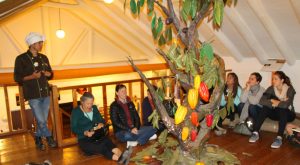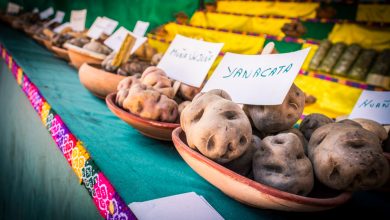Cacao and the Amazon

Peru exported more cacao in 2014 than in 2013, mostly to Europe, according to recent figures provided by Adex, the Peruvian Association of Exporters. Peru sent $247.4 million dollars of cocoa abroad, especially to the Low Countries that are famous for their chocolate.
This occurs at a time when there is increasing concern for disease in other parts of the cacao producing world, and the use of child labor to produce cocoa. Most of Peru’s production comes from family farms throughout its many valleys on the eastern slopes of its Andes mountains.
At the same time, however, word comes that plant researchers are increasingly challenging the idea that the Mayas domesticated cacao. The Spanish certainly found its beans fermented and ground for use in a drink which they returned to Europe and which becomes our hot chocolate. But cacao, according to path breaking work by Motamayor and colleagues has shown that cacao probably originated in the Amazon basin here there is a wide variety of wild plants and a range of domesticated and semi-domesticated forms of the plant. Furthermore, in the Amazon, such as in Peru, one find cross pollination between cultivated forms of cacao and the wild ones leading to constant innovation naturally.
It is argued that people in the Amazon did not value the cacao plant for its seeds until fairly recently. Instead they are argued to have valed its fruit pods which vary widely in taste. Plant scientists argue, as a result, indigenous people of the Amazon basin selected fruit with good flavor and size. These they transported back to their villages, it is said, and cast the seeds into their garbage dumps around the edge of the village. There the seeds sprouted and produced cacao of the type they liked leading to a process of semi-domestication.
Not only did people eat the fruit, they also made an alcoholic beverage from the fruit, a kind of chicha as it is called in highland Peru.

This may be how the seeds arrived in Central America more than fifteen hundred years ago to produced the famous criollo cacao that is the basis of much development of cacao in todays world.

Nevertheless, the Amazon remains an important area of genetic variation that will probably prove useful as people seek varieties able to resist the plagues that assault cacao, especially in Africa.
Most of the cacao in Cusco, one of Peru’s important regions for cacao production, is from the district of Echarate in La Convención province. There it is cultivated in small parcels, mostly by people who a generation or so ago migrated down from the highlands and began to learn how to farm in the tropics. Yields are relatively low and the production is not very technified.
While someone may have done the research exploring indigenous cacaos and especially the semi-domestication of cacao, which probably exists, among local indigenous peoples, I have not come on it yet. It strikes me that this is an important concern, especially since the indigenous cacao, called chunchu, which has an amazing flavor, is increasingly winning recognition and developing demand.
The chuncho cacao is named using a word in Quechua that refers to lowland Indians who have long had a relationship and presence in the minds and dances of highlanders. As a result, it would be intriguing for scientists to actually look at the ways in which cacao is cultivated and used in Matsiguenka and other indigenous communities of Echarate and La Convención, and not simply worry about the varieties cultivated for their seeds.
References:
Charles R. Clement, et al., Origin and Domestication of Native Amazonian Crops, Diversity (2010) 2: 72-106.
Claudia Chumacero de Schawe, Gene Flow and Genetic Diversity in Cultivated and Wild Cacao (Theobroma) in Bolivia. American Journal of Botany. Nov2013, Vol. 100 Issue 11, p2271-2279.
Isaías Merma and Alberto Julca, Caracterización y evaluación de la sustentabilidad de fincas en Alto Urubamba, Cusco, Perú, Ecología Aplicada, 11(1), 2012
J.C. Motamayor, et al., Cacao domestication I: the origin of the cacao cultivated by the Mayas, Heredity (2002) 89: 380-386
J.C.Motamayor, et al., Cacao domestication II: progenitor germplasm of the Trinitario cacao cultivar, Heredity (2003) 91: 322-331
Tomas Evert, et al., Present Spatial Diversity Patterns of Theobroma cacao L. in the Neotropics Reflect Genetic Differentiation in Pleistocene Refugia Followed by Human-Influenced Dispersal, PLoS ONE. Oct2012, Vol. 7 Issue 10, Special section p1-17.




